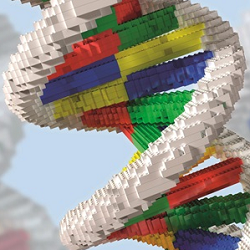
Everything in Nature is made from just 20 different amino acid building blocks; imagine what you could do with 200.
Proteins define Biology and set the limit of what Biology can and can’t do. Since all living things contain DNA and DNA encodes how to make proteins, then all life on Earth is made from proteins – out of building blocks called amino acids of which there are just 20.
Nature uses chemistries in fantastically intricate and varied ways (creating trees and flamingos) but there are other chemistries which simply lie outside Nature’s reach. Expanding the genetic code allows us to go beyond that.
My research looks at inserting unnatural amino acids into the genetic code. We add new chemistries into proteins alongside the natural 20. So far we have been able to expand the genetic code by adding an additional two unnatural amino acids. A very good start, but we want to do better.
To go further, we need to improve the protein-building machinery within cells. I am designing new enzymes (synthetases) to carry unnatural amino acids and install them into proteins. Like adjusting any complicated system without re-building from scratch, we have to make improvements without disrupting what is already there. Our new enzymes have to work alongside the natural enzymes without any cross-interference. By rational design I am trying to develop new synthetic enzymes which can be put together in a modular fashion. This will give lots of new synthetases able to work in parallel to install many unnatural amino acids at the same time.
This area of synthetic biology is called genetic code expansion. It is a powerful technique. By reworking Nature at the genetic level we can simultaneously extend the capabilities of Biology, redefine what it fundamentally means to be Biological, and design completely new Biology tailored to our needs. Stay tuned.
Julian Willis
NanoDTC PhD Student Cohort 2013
MRC Laboratory
Cover Image- Credit- Pharmaceutical Journal

